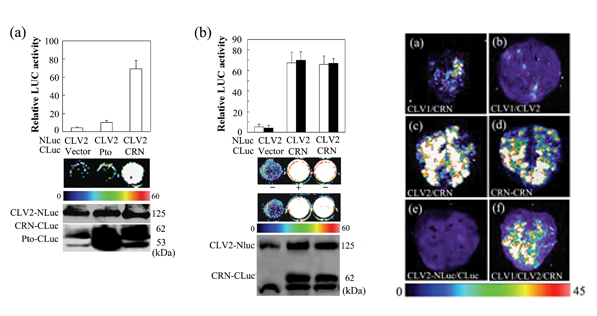Recently, the LIN Jinxing's research group in Key Laboratory of Photosynthesis and Environmental Molecular Physiology, Institute of Botany, Chinese Academy of Sciences published a research paper on The Plant Journal,( 2010 (6) 2: 223-233(11)). The summary of this paper is as follows:
In Arabidopsis, CORYNE (CRN), a new member of the receptor kinase family, was recently isolated as a key player involved in the CLAVATA3 (CLV3) signaling pathway, thereby playing an important role in regulating the development of shoot and root apical meristems. However, the precise relationships among CLAVATA1 (CLV1), CLAVATA2 (CLV2), and CRN receptors remain unclear. Here, we demonstrate the subcellular localization of CRN and analyze the interactions among CLV1, CLV2, and CRN using firefly luciferase complementation imaging (LCI) assays in both Arabidopsis mesophyll protoplasts and Nicotiana benthamiana leaves. Fluorescence targeting showed that CRN was localized to the plasma membrane. The LCI assays coupled with co-immunoprecipitation assays demonstrated that CLV2 can directly interact with CRN in the absence of CLV3. Additional LCI assays showed that CLV1 did not interact with CLV2, but can interact weakly with CRN. We also found that CLV1 can interact with CLV2-CRN heterodimers, implying that these three proteins may form a complex. Moreover, CRN, rather than CLV1 and CLV2, was able to form homodimers without CLV3 stimulation. Taken together, our results add direct evidence to the newly proposed two-parallel receptor pathways model and therefore provide new insights into the CLV3 signaling pathway.
Keywords: CORYNE; CLAVATA1; CLAVATA2; Arabidopsis mesophyll protoplasts; Nicotiana benthamiana; firefly luciferase complementation imaging assay
DOI: 10.1111/j.1365-313X.2009.04049.x

Recently, the LIN Jinxing's research group in Key Laboratory of Photosynthesis and Environmental Molecular Physiology, Institute of Botany, Chinese Academy of Sciences published a research paper on The Plant Journal,( 2010 (6) 2: 223-233(11)). The summary of this paper is as follows:
In Arabidopsis, CORYNE (CRN), a new member of the receptor kinase family, was recently isolated as a key player involved in the CLAVATA3 (CLV3) signaling pathway, thereby playing an important role in regulating the development of shoot and root apical meristems. However, the precise relationships among CLAVATA1 (CLV1), CLAVATA2 (CLV2), and CRN receptors remain unclear. Here, we demonstrate the subcellular localization of CRN and analyze the interactions among CLV1, CLV2, and CRN using firefly luciferase complementation imaging (LCI) assays in both Arabidopsis mesophyll protoplasts and Nicotiana benthamiana leaves. Fluorescence targeting showed that CRN was localized to the plasma membrane. The LCI assays coupled with co-immunoprecipitation assays demonstrated that CLV2 can directly interact with CRN in the absence of CLV3. Additional LCI assays showed that CLV1 did not interact with CLV2, but can interact weakly with CRN. We also found that CLV1 can interact with CLV2-CRN heterodimers, implying that these three proteins may form a complex. Moreover, CRN, rather than CLV1 and CLV2, was able to form homodimers without CLV3 stimulation. Taken together, our results add direct evidence to the newly proposed two-parallel receptor pathways model and therefore provide new insights into the CLV3 signaling pathway.
Keywords: CORYNE; CLAVATA1; CLAVATA2; Arabidopsis mesophyll protoplasts; Nicotiana benthamiana; firefly luciferase complementation imaging assayDOI: 10.1111/j.1365-313X.2009.04049.x

